The idea of what constitutes a “surplus firearm” has different meanings depending where you are in the world. Surplus firearms in the U.S. means extra on hand or dated equipment. In other countries, it could mean one step away from scrap metal. We try to avoid the latter, but we are always on the lookout for a diamond in the rough, and thought we’d look at a few surplus 9mm Luger and 9mm Kurz (380 Auto) pistols. We wanted to look at these pistols through the lens of an inexpensive pistol that would be suited as a sand pit plinker, but in a pinch, it perhaps could be called on to defend the ranch. The problem with older surplus pistols is the lack or scarcity of spare parts, including magazines. By definition, all surplus weapons have been used, and some used more than others.
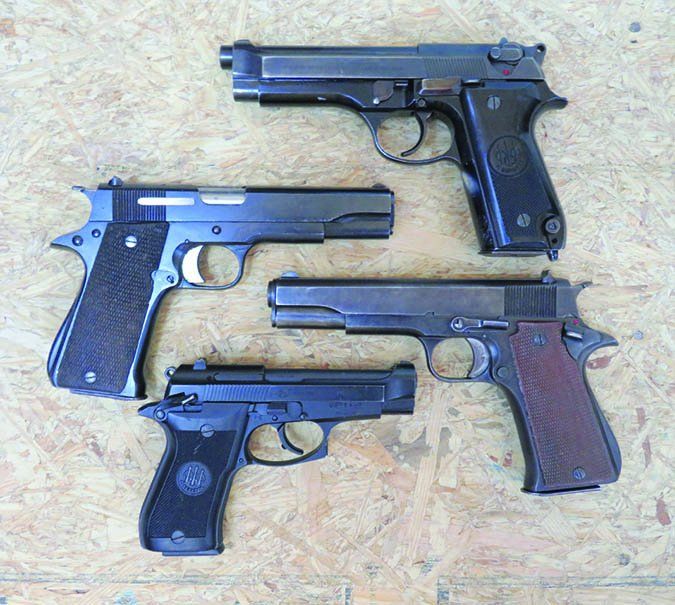
We chose four pistols that are fairly common and easy to find online to go bargain hunting: Two are Berettas, a Model 92S and Model 85F, made in Italy by P. Beretta S.P.A., and two are Star pistols, made in Spain by Star Bonifacio Echeverria, S.A., a Model Super B and Model B. The Star Model Super B looks like it is ready for the scrap yard and the older Model B looked well used, but as we found out, both still had some teeth. The Beretta 92S is a second-generation 92, which evolved into the 92FS. The 92S is a lot more of a European gun than the 92FS, which definitely has US influence. The Beretta 85F is a smaller version of the 92FS and is the most modern of the pistols tested.
In past issues we have tested some old-school combat pistols and found them lacking, which makes sense. A horse worked a century and a half ago; but now we (can) drive Hummers. Accordingly, we had to make some accommodations for these guns’ age. Since these are older pistols, we did not test with proofing loads or +P+ loads. These pistols were not designed for that type of high-pressure ammunition, and we had no desire to taste Italian or Spanish steel. Not that we are implying these are substandard pistols. These pistols are safe when used with ammunition originally intended for them. What we did want to find out was if different bullets types would impact performance. For instance, the Star pistols were manufactured before hollow-point bullets were popular, and we figured they might choke on hollow-point ammunition. We also wanted to see if different bullet weights would cause a stovepipe jam or failure to eject. We used off-the-shelf 9mm Luger ammo consisting of Hornady American Gunner with 115-grain XTP jacketed hollow points ($47/75 rounds), Aguila 124-grain FMJs ($17/50), and SIG Sauer 115-grain FMJ ($18/50). We found all three ammo types cycled flawlessly through the pistols with no issues. In the Beretta 85F, we fired 91-grain FMJs from Tula, 90-grain Speer Gold Dot hollow points, and Hornady Critical Defense 90-grain XTPs, which feature a hollow-point bullet with a polymer insert to facilitate expansion.
Range Data
| Hornady American Gunner 9mm Luger 115-gr. XTP | Beretta Model 92S | Star Model Super B | Star Model B |
| Average Velocity | 1110 fps | 1110 fps | 1138 fps |
| Muzzle Energy | 309 ft.-lbs. | 309 ft.-lbs. | 331 ft.-lbs. |
| Smallest Group | 1.6 in. | 2.6 in. | 2 in. |
| Average Group | 1.8 in. | 3.2 in. | 2.3 in. |
| SIG Sauer 9mm Luger 115-gr. FMJ | |||
| Average Velocity | 1103 fps | 1134 fps | 1296 fps |
| Muzzle Energy | 316 ft.-lbs. | 328 ft.-lbs. | 429 ft.-lbs. |
| Smallest Group | 2.9 in. | 2.5 in. | 2.3 in. |
| Average Group | 3 in. | 2.8 in. | 2.7 in. |
| Aguila 9mm Luger 124-gr. FMJ | |||
| Average Velocity | 1055 fps | 1085 fps | 1080 fps |
| Muzzle Energy | 307 ft.-lbs. | 324 ft.-lbs. | 321 ft.-lbs. |
| Smallest Group | 1.2 in. | 1.9 in. | 3 in. |
| Average Group | 1.7 in. | 2 in. | 3.2 in. |
| Beretta Model 85F 380 ACP | |||
| Average Velocity | 866 fps | 993 fps | 943 fps |
| Muzzle Energy | 152 ft.-lbs. | 197 ft.-lbs. | 181 ft.-lbs. |
| Smallest Group | 1.2 in. | 1.4 in. | 1.6 in. |
| Average Group | 1.4 in. | 1.7 in. | 1.7 in. |
| Notes: To collect accuracy data, we fired five-shot groups from a bench using a rest. Distance: 25 yards with open sights. We recorded velocities using a ProChrono digital chronograph set 15 feet from the muzzle. | |||
For accuracy testing, we placed the pistols on a bench rest to fire at targets set at 25 yards. In speed-firing exercises, we shot at targets at 7 yards, performing both Bill Drills and Mozambique Drills. The object with the Bill Drill is to fire as fast and as accurately as possible to hit an 8-inch zone. The Mozambique requires two fast shots to center of mass and a one to the head. All must be within their zones to be successful. This is what we found out when we exercised these old pistols.
Beretta Model 85F 380 Auto, $350-$375
GUN TESTS GRADE: A
The 85F is very shootable due to the grip size. It felt like a shrunk 92FS. We liked the accuracy and ease of use.
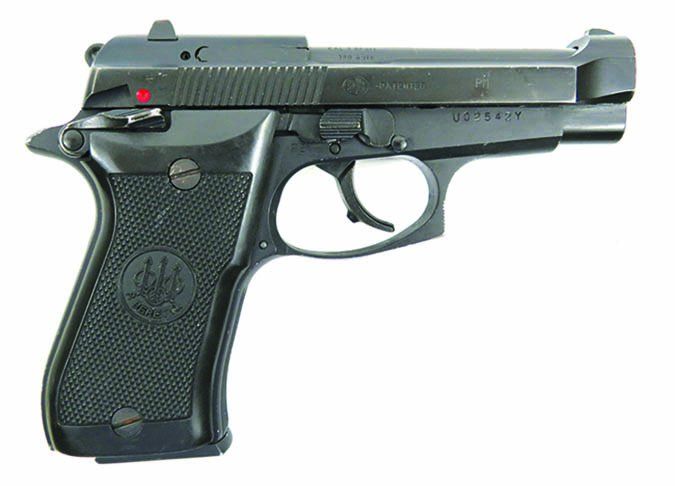
| ACTION TYPE | Blowback |
| OVERALL LENGTH | 6.8 in. |
| OVERALL HEIGHT | 4.7 in. |
| MAX WIDTH | 1.4 in. |
| WEIGHT UNLOADED | 23 oz. |
| WEIGHT LOADED | 25.4 oz. |
| SLIDE MATERIAL | Steel |
| RECEIVER MATERIAL | Aluminum alloy |
| FRONT STRAP HEIGHT | 3.7 in. |
| REAR STRAP HEIGHT | 2.2 in. |
| BARREL LENGTH | 3.2 in. |
| PISTOL GRIP MATERIAL | Checkered polymer |
| GRIP THICKNESS (max) | 1.2 in. |
| GRIP CIRCUMFERENCE (max) | 5.3 in. |
| MAGAZINE | 8-rd. steel |
| REAR SIGHT | Steel, fixed, white dot |
| FRONT SIGHT | Steel, fixed, white dot |
| SIGHT RADIUS | 4.9 in. |
| TRIGGER PULL (DA) | 8.5 lbs. |
| TRIGGER PULL (SA) | 4.8 lbs. |
| TRIGGER SPAN (DA) | 4.5 in. |
| TRIGGER SPAN (SA) | 3.1 in. |
| SAFETY | Ambidextrous 2-position lever |
| WARRANTY | N/A |
| TELEPHONE | (800) 237-3882 |
| WEBSITE | Beretta.com |
| MADE IN | Italy |
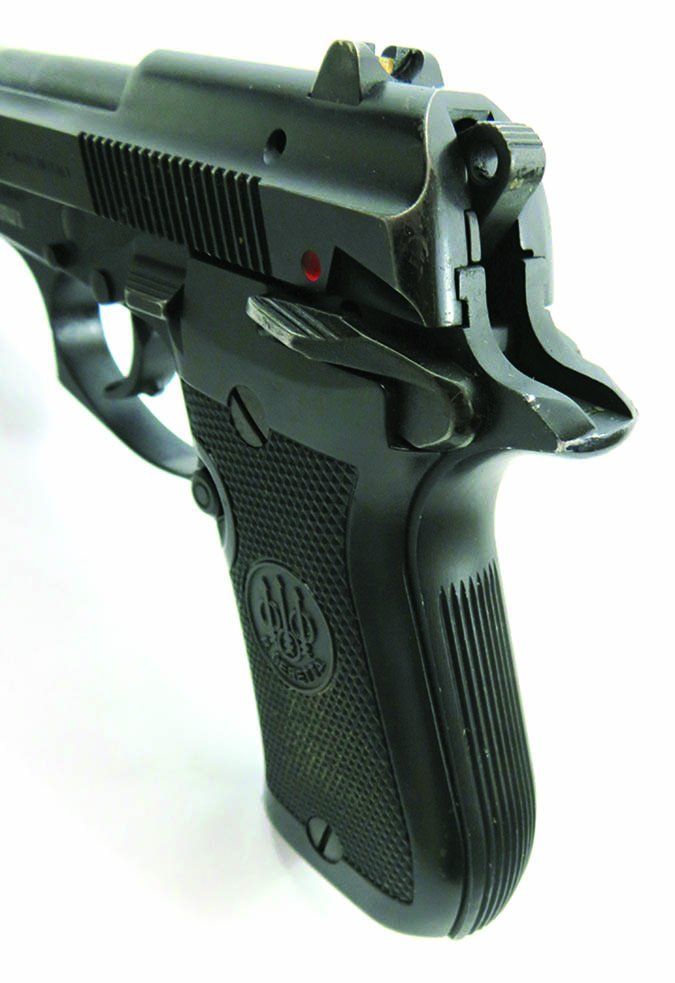
While the Model 92S showed its age due to features, the Model 85F was similar to a Model 92FS except in a smaller package. That’s because the Model 85F was designed to mimic the 92FS. The 85F was manufactured in 1990, and our example is an Italian-made surplus police pistol. It was in very good condition, with finish missing from sharp edges, but otherwise the pistol looked like it was not fired often. When 380 Auto pistols began to be made with polymer frames in subcompact sizes, the larger 85F lost favor. In our opinion the 85F is no pocket pistol, but it does offer better shootability than a subcompact pistol. The trade-off is a larger pistol that is less concealed-carry friendly.
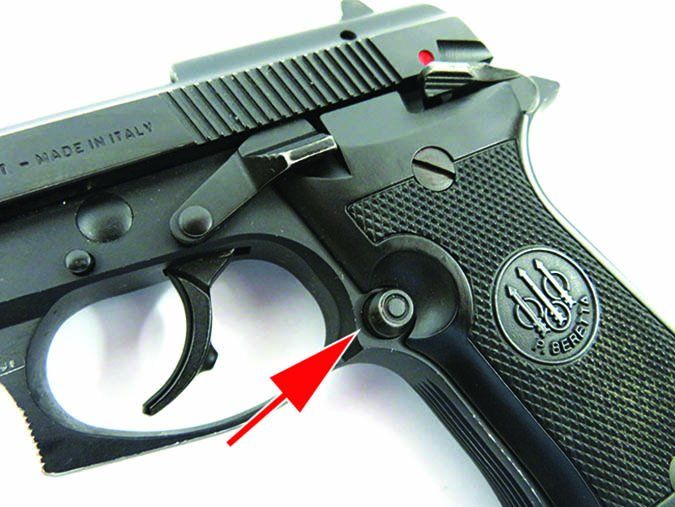
The receiver of the 85F is metal, aluminum alloy, with serrations in the front and rear grip straps. The controls on the 85F were also large and easy to manipulate. The ambidextrous safety clicked on and off precisely. The plastic grip panels had plenty of checkering for a secure grip. In hand, the 85F feels like a full-size pistol. There is no need to curl your small finger under the butt. The magazine release was located near the thumb of a right-hand shooter, so it was easy to work the small 85F. The pistol used a single-stack steel magazine. The sights were fixed and had a white dot on the front blade and a white dot below the notch of the rear sight. Align the dots vertically to aim. Team members liked these sights compared to the 92S; more user friendly and more contrast. We would have liked more serrations on the slide to make the slide easier to manipulate.
Rotate the frame-mounted safety up in the Safe position, and the trigger moves freely but does not engage the sear and the slide cannot be manipulated. Flick the safety down for the Fire position. In DA mode, the trigger had a 8.5-pound press. In SA mode, there was some slack to take up before the trigger broke at 4.8 pounds. The 85F was fast and simple to field strip, like any Series 92 from Beretta.
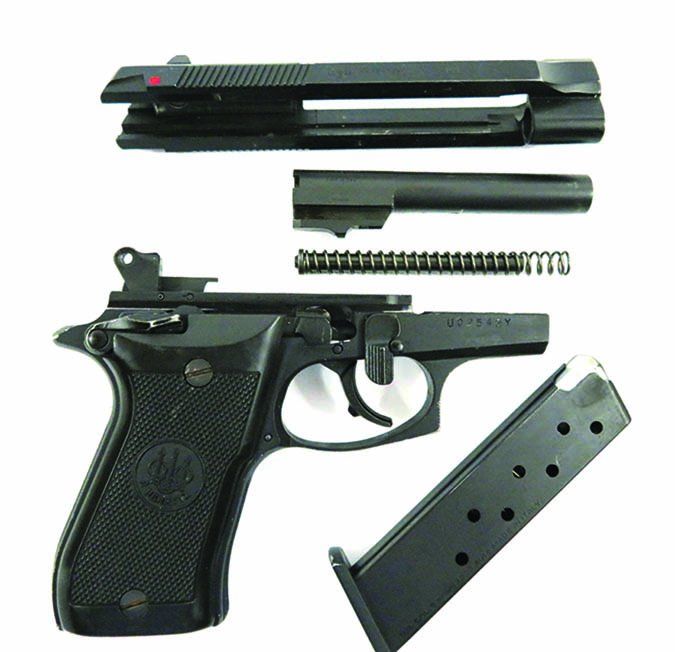
At the range, the 85F showed some excellent accuracy, even with the inexpensive Tula 90-grain FMJ ammo. One tester was able to shoot a five-shot group that measured 1.2 inches. With Hornady 90-grain XTPs, our average five-shot group measured 1.7 inches. With Speer Gold Dot ammunition our average five-shot group measured 1.6 inches. The 85F was a capable shooter. With a subcompact 380 Auto pistol with diminutive sights and smaller grip, we would not have the same accuracy results. We did feel recoil with the 85F, more so than the 92S, since the 85F is lighter. This small Beretta operated flawlessly.
Our Team Said: There are smaller 380 Auto pistols available at the same price point, and pistols chambered in 9mm that are the same size or smaller than the 85F at a higher price point. We liked the accuracy of the 85F and its ease of use. Recoil was manageable, even though the pistol was lightweight. In our opinion, the cost was reasonable and we would not hesitate to use this pistol as a concealed-carry piece.
Beretta Model 92S 9mm Luger, $280-$310
GUN TESTS GRADE: B+
The 92S is pure European. This is a very shootable pistol for hundreds less than a new Beretta.
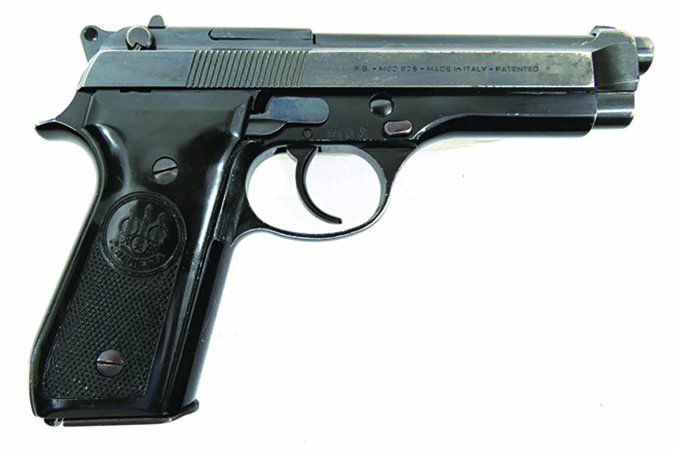
| ACTION TYPE | Blowback |
| OVERALL LENGTH | 6.8 in. |
| OVERALL HEIGHT | 4.7 in. |
| MAX WIDTH | 1.4 in. |
| WEIGHT UNLOADED | 23 oz. |
| WEIGHT LOADED | 25.4 oz. |
| SLIDE MATERIAL | Steel |
| RECEIVER MATERIAL | Aluminum alloy |
| FRONT STRAP HEIGHT | 3.7 in. |
| REAR STRAP HEIGHT | 2.2 in. |
| BARREL LENGTH | 3.2 in. |
| PISTOL GRIP MATERIAL | Checkered polymer |
| GRIP THICKNESS (max) | 1.2 in. |
| GRIP CIRCUMFERENCE (max) | 5.3 in. |
| MAGAZINE | 8-rd. steel |
| REAR SIGHT | Steel, fixed, white dot |
| FRONT SIGHT | Steel, fixed, white dot |
| SIGHT RADIUS | 4.9 in. |
| TRIGGER PULL (DA) | 8.5 lbs. |
| TRIGGER PULL (SA) | 4.8 lbs. |
| TRIGGER SPAN (DA) | 4.5 in. |
| TRIGGER SPAN (SA) | 3.1 in. |
| SAFETY | Ambidextrous 2-position lever |
| WARRANTY | N/A |
| TELEPHONE | (800) 237-3882 |
| WEBSITE | Beretta.com |
| MADE IN | Italy |
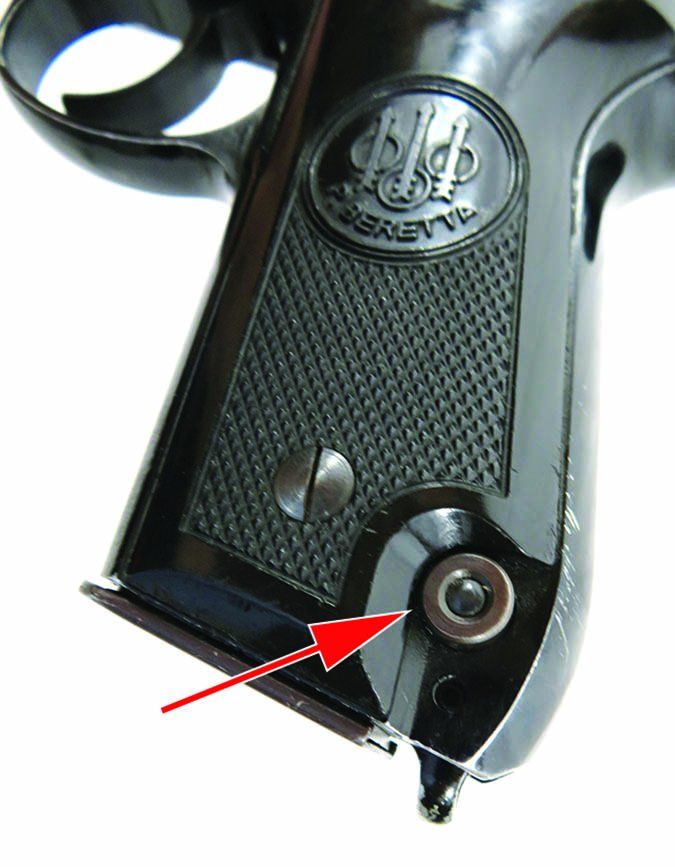
The Model 92S is basically a precursor to the Model 92FS. The original Model 92 was introduced in 1976 and had a frame-mounted safety similar to the current Taurus 92 pistol or a 1911-style pistol. Police and military officers in Italy wanted a slide-mounted safety, so in 1977, Beretta introduced the 92S, the second generation 92, and started to sell these pistols to police and LE agencies around the world. Where the 92S differs from the 92FS is in the grip, hammer pin, receiver shape, and magazine release, among other details. The 92FS has an enlarged hammer pin to stop the slide from flying off the receiver if it cracks. This was done at the request of the U.S. military after testing the 92S with high-pressure loads. The 92S has the safety lever mounted in the slide. Rotating it up puts it in the Fire position and exposes a red dot and readies the pistol to go bang. Rotate it down into the Safe position and the trigger is disengaged, but the slide can still be manipulated. The hammer cannot be cocked manually. With the pistol cocked, rotating the lever to the Safe position allows the hammer to safely move forward. The safety is not ambidextrous.
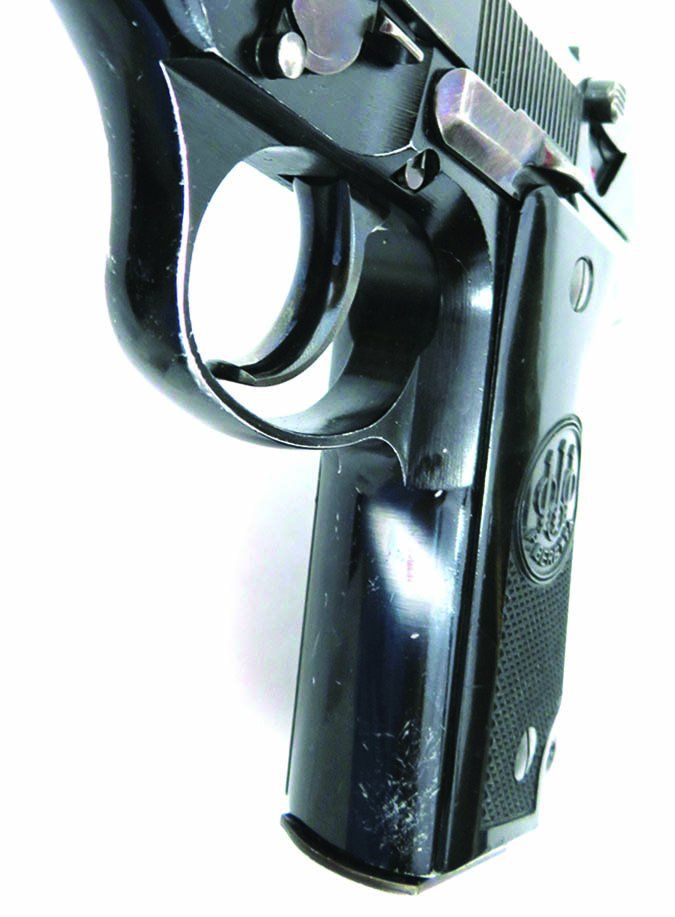
The receiver has a rounded trigger guard, and the magazine release is located in the butt. Press and hold the button and the magazine falls free. If you have ever fired a pistol in snow or tall grass, you will understand why the magazine release was located here. Using the support hand to manipulate the magazine-release button drops the empty magazine into the palm of the support hand, where the magazine can be withdrawn. The magazine-release button works like a brake, so a user needs to remove the magazine. This is a European trait of the 92S. Here in the US, we are accustomed to dumping the empty magazine and while it is falling insert a fresh magazine. Testers unaccustomed to the butt-release magazine were at a loss when the slide locked back, but with training and practice, we could replace the magazine efficiently. Most magazines made for the 92FS are compatible with the 92S, so finding extra magazines—both factory and aftermarket—is simple.
The front and rear grip straps are smooth, and there was a lanyard loop attached at the butt. The 92S feels rounded in hand, different than the 92FS. The plastic grips were checkered on the bottom portion but not the top, which we thought was odd. We would have like fully checkered grips to better adhere our hand to the pistol. Field-stripping was like any other Beretta Series-92 pistol—fast and simple.
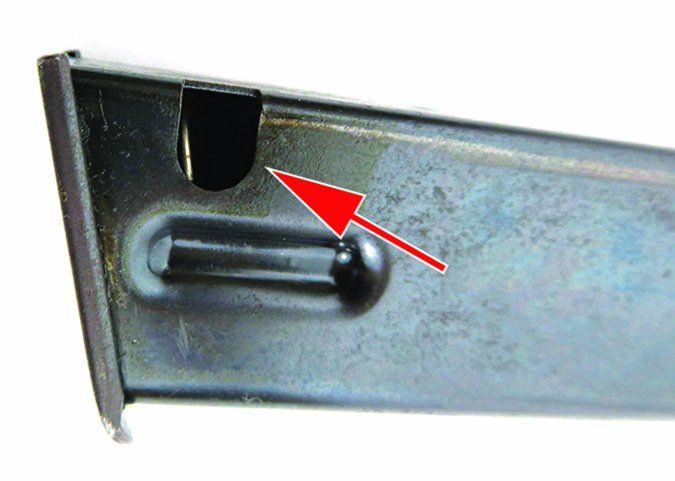
The example we tested showed signs of holster wear but little actual firing wear. The bluing was worn, and we would rate this pistol 80-75 percent by NRA standards. The slide had no wiggle. It was tight. The trigger measured 11 pounds in DA mode and felt like it. In SA mode, there was a lot of take up and a bit of a mushy trigger. Not a show-stopper by any means, just a typical service pistol. The sights were small, fixed, and without contrasting dots or lines. On a dark background, the sights could get lost.
All ammunition cycled flawlessly through the 92S. Magazines seated easily. We would have liked more slide serrations to make the pistol easier to cock.
Bench-rest accuracy was good, averaging about 2 inches for five rounds at 25 yards. One team member consistently grouped five shots at about 1.22 inch with the 124-grain FMJ Aguila ammunition. The Hornady American Gunner ammo with a 115-grain JHP was no slouch either, with average groups measuring 1.8 inches. We did notice the 92S had a pleasant recoil. The pistol magazine release took some getting used to and slowed us down when it came to rapid reloads.
Our Team Said: The 92S is no modern-day 92FS Beretta pistol, but it still provides an excellent example of Beretta’s 92 series performance. The 92S is about half the cost of a new 92FS. We wouldn’t hesitate to use this as a defense weapon.
Star Model B 9mm Luger, $220 to $240
GUN TESTS GRADE: C
The Model B was accurate and had a well-broken-in trigger. The slide did not lock back all of the time.
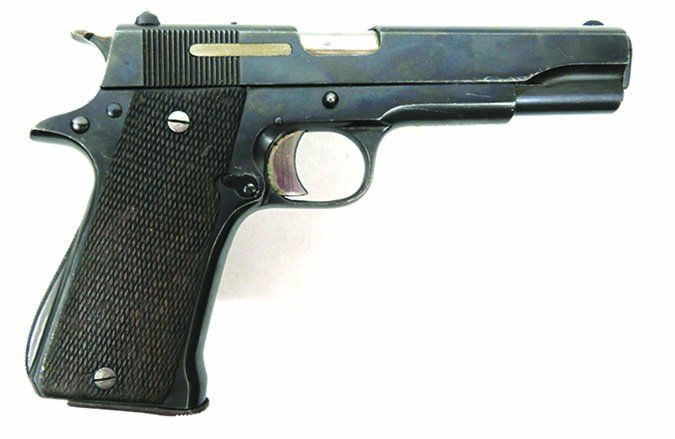
| ACTION TYPE | Cammed locking lug |
| OVERALL LENGTH | 8.5 in. |
| OVERALL HEIGHT | 5.5 in. |
| MAX WIDTH | 1.2 in. |
| WEIGHT UNLOADED | 39.6 oz. |
| WEIGHT LOADED | 42.8 oz. |
| SLIDE MATERIAL | Steel |
| RECEIVER MATERIAL | Steel |
| FRONT STRAP HEIGHT | 3.7 in. |
| REAR STRAP HEIGHT | 3.2 in. |
| BARREL LENGTH | 5 in. |
| PISTOL GRIP | Checkered polymer |
| GRIP THICKNESS (max) | 1.1 in. |
| GRIP CIRCUMFERENCE (max) | 5.8 in. |
| MAGAZINE | 8-rd. steel |
| REAR SIGHT | Steel, fixed notch |
| FRONT SIGHT | Steel, fixed blade |
| SIGHT RADIUS | 6.2 in. |
| TRIGGER PULL WEIGHT | 5.3 lbs. |
| TRIGGER SPAN | 2.7 in. |
| SAFETY | 2-position lever |
| WARRANTY | N/A |
| TELEPHONE | N/A |
| WEBSITE | N/A |
| MADE IN | Spain |
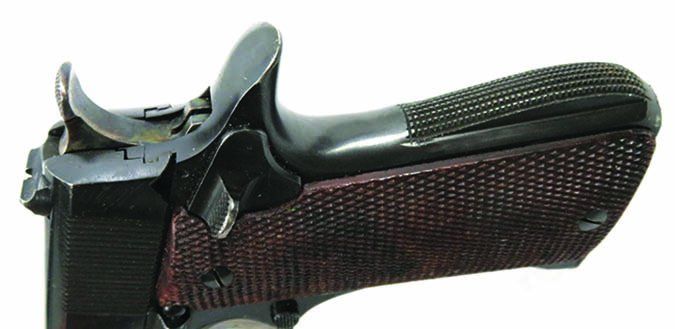
The Star Model B was manufactured from 1931 and 1983. This design was used on a limited basis by German police and some military units during WWII. Our sample was built in 1977. The Model B design was a knock-off of the Colt 1911-style pistol. The slide stop looks and acts like a slide stop on a 1911, as does the thumb safety and magazine release. In fact the Model B has been used in numerous movies and TV shows as a stand in for the 1911. The reason for using the Model B in lieu of the 1911 in 45 ACP is because the Star cycles on blanks and looks like a dead ringer for the 1911. The Model B operates similarly to a 1911, with a few differences. The trigger pivots rather than slides, there is no grip safety on the Star, the receiver is machined with an arch to look like the arched mainspring housing on a 1911A1, and the front strap flares out. Earlier Model Bs had a straight front strap like a 1911.
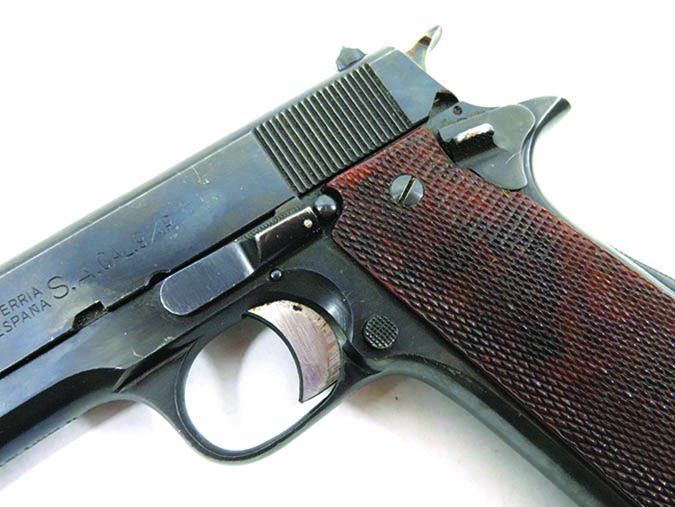
Our sample pistol would rate 70 percent according to NRA standards. Bluing was worn at sharp edges. The hammer showed some case hardening. One grip panel was plastic while the other was wood. The trigger had a bit of take up and broke cleanly at 5.3 pounds. It actually seemed less. The checkered spur hammer offered good purchase when cocking it. The Model B field-stripped like a typical military 1911.
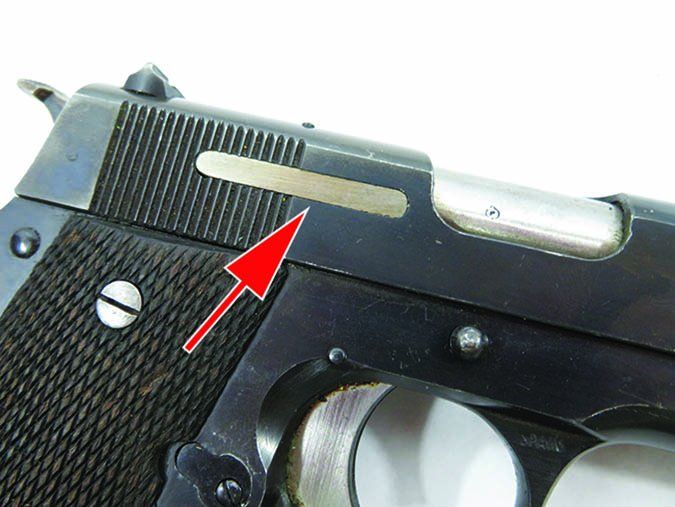
There was a bit of rattle when we shook the pistol. The slide-to-receiver fit was fairly tight. It came with one 8-round steel single-stack magazine that was rusty and worn. It looked like someone fussed with the feed lip using a pair of pliers. We doubted the Model B would operate with the magazine, but were largely proved wrong. In hand, the Model B was skinny and easy to grip. The fixed sights were similar to those on a 1911A1.
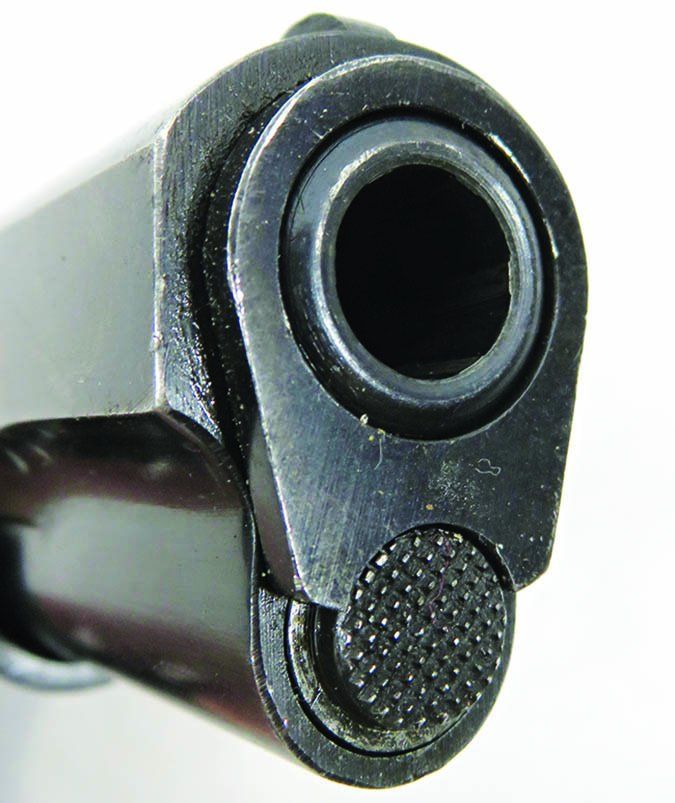
From a rest at 25 yards, the Model B proved to be quite accurate for an old-timer. We averaged 2.5-inch groups with five shots. With Hornady American Gunner, one team member shot a 2-inch group. Within the first magazine, we found the slide did not lock back. We squirted the Model B with CLP and worked the slide, and problem still plagued us at times. If we owned this pistol we’d give a detail strip and thorough cleaning, as well as buy—if we could find them—more magazines.
Our Team Said: The Model B was inexpensive but did not operate as designed—the slide did not lock back. We liked plinking with it, but we would choose the Super B over the Model B if we wanted a 1911-style pistol to both plink and protect.
Star Model Super B 9mm Luger, $290 to $320
GUN TESTS GRADE: B
The Super B was pleasant to shoot and operate and gave good accuracy. The trigger was good and recoil mild. This would make a good addition to a historic 9mm pistol collection and could still protect the home with no worries.
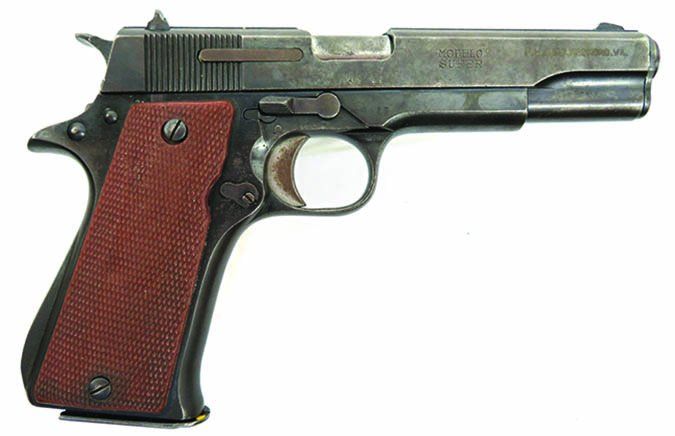
| ACTION TYPE | Cammed locking lug |
| OVERALL LENGTH | 8 in. |
| OVERALL HEIGHT | 5.5 in. |
| MAX WIDTH | 1.3 in. |
| WEIGHT UNLOADED | 36.6 oz. |
| WEIGHT LOADED | 39.8 oz. |
| SLIDE MATERIAL | Steel |
| RECEIVER MATERIAL | Steel |
| FRONT STRAP HEIGHT | 3.7 in. |
| REAR STRAP HEIGHT | 3.2 in. |
| TRIGGER SPAN | 2.7 in. |
| BARREL LENGTH | 5 in. |
| PISTOL GRIP | Checkered polymer |
| GRIP THICKNESS (max) | 1.1 in. |
| GRIP CIRCUMFERENCE (max) | 5.8 in. |
| MAGAZINE | 8-rd. steel |
| REAR SIGHT | Steel, fixed notch |
| FRONT SIGHT | Steel, fixed blade |
| SIGHT RADIUS | 6.2 in. |
| TRIGGER PULL WEIGHT | 4.8 lbs. |
| TRIGGER SPAN | 2.7 in. |
| SAFETY | 2-position lever |
| WARRANTY | N/A |
| TELEPHONE | N/A |
| WEBSITE | N/A |
| MADE IN | Spain |
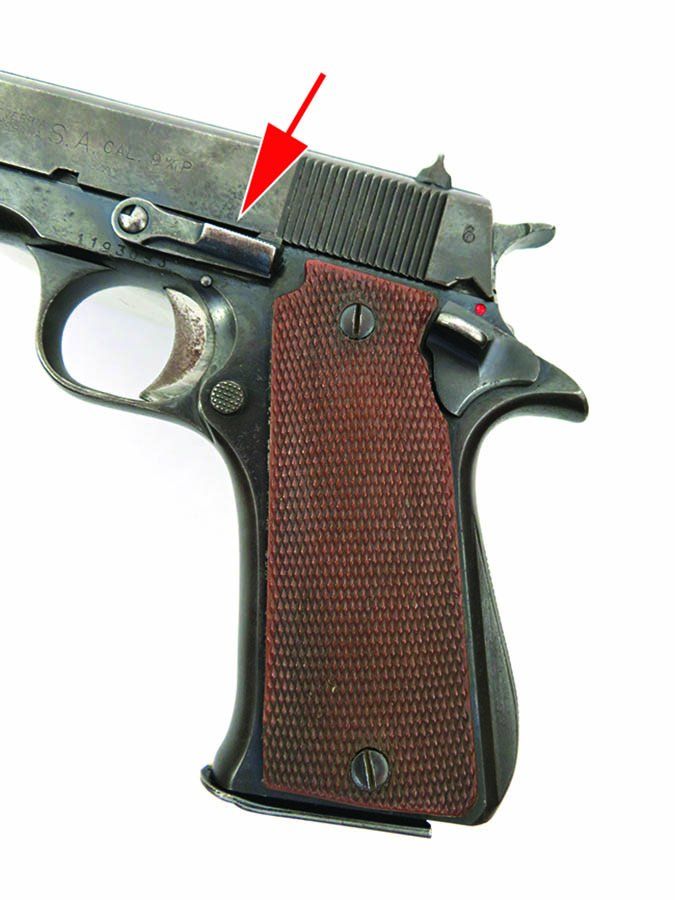
The Star Model Super B was manufactured from 1946 and 1983 and is an enhanced version of the Model B. The Super B was used by Spain’s military. Like all Star B-series models, the Super B continued to look and operate like a 1911 pistol but with enhancements. The slide stop looks and acts like a slide stop on a 1911, but it also functions as a takedown lever. The thumb safety also looks and operates like a 1911 thumb safety. While the Super B does look and operate like a 1911, it actually has a trigger that pivots. It uses a cammed lug on the barrel. The Super B also has features that are seen in current 9mm pistols, like a captured takedown lever and loaded-chamber indicator.
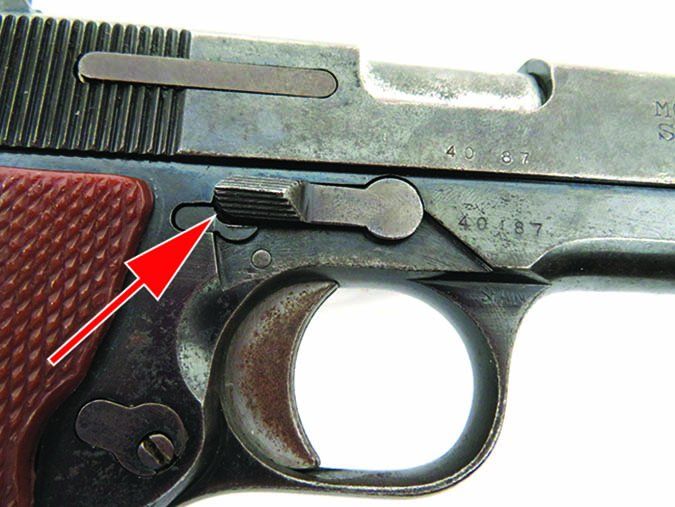
Our example looked long in the tooth and ready for the scrap yard. We would rate the Super B tested at 60 percent, according to NRA standards. There was some bluing left and the checkered plastic grips looked a bit faded. A blast of CLP and the Star was ready for action. As mentioned, the trigger pivots; it does not slide like a 1911 trigger. It broke cleanly at 4.8 pounds, which we liked. The receiver has an arch machined into the rear grip strap, giving it the appearance of arched mainspring housing in a 1911A1 pistol.
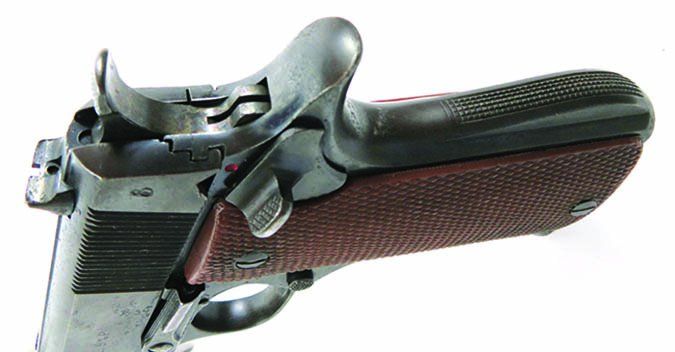
The Super B also does not have a grip safety like a 1911. The spur hammer was checkered and gave good purchase. The Star field-stripped like a cross between a 1911 and SIG P226. The bushing at the muzzle is rotated to relieve tension on the recoil spring, like a 1911, then the slide stop is rotated down to allow the slide assembly to move forward and off the receiver. The process was easy and required no tools. If you have issues depressing the recoil spring, you can use the corner of the magazine to depress it to allow the bushing to be rotated. The Star came with two steel single-stack magazines. The 8-round magazines were easy to load. The magazine release button is the same as a 1911. Magazines drop free like those from a 1911.
In hand, the Star felt thin and comfortable. The fixed sights were larger than those on a Government Issue 1911A1. The rear sight was knocked to one side, so we assumed the pistol would not shoot to point of aim. It did shoot to the left, but a brass punch and hammer cured that issue. The slide serrations were similar to a 1911A1 and offered enough surface to grip comfortably.
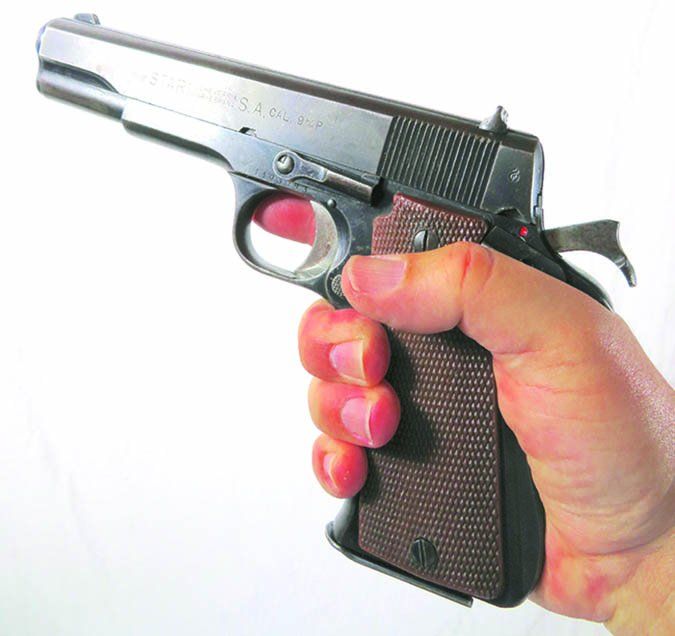
At 25 yards, we found the Super B performed like a super star—for a surplus handgun anyway. The trigger pull and sights were adequate, allowing one tester to shoot a five-shot group that measured 1.8 inches with the Hornady American Gunner loaded with 115-grain XTP bullets. We assumed the Hornady American Gunner ammo would trip up the Star. Not a chance. The Super B chewed through all the ammunition without any issues. We were surprised. Lesson: Don’t judge a pistol’s performance by its finish, or lack thereof.
Our Team Said: The cost of the Star was reasonable for a plinker. We liked shooting this pistol since recoil was pleasant, the trigger broke cleanly, it fired inexpensive 9mm ammo, and the sights were usable. Replacement parts could be an issue. Our pistol was so reliable that we would use it as a house gun, but would opt for the Beretta 92S over the Super B due to the magazine capacity and availability of parts.
Special thanks to Eastern Outfitters of Hampstead, North Carolina, for their assistance. Written and photographed by Robert Sadowski, using evaluations from Gun Tests team testers.




























